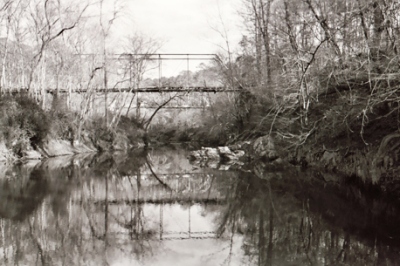
Alright, now that we've gone as far north as Plum Branch, let's go just a little bit east, into the Sumter National Forest. Three creeks flow through here: Wine Creek, Steven's Creek, and Turkey Creek. I don't know a whole lot about the area, other than that the mountain biking is really great. Oh, and I also know that two Revolutionary War battles were fought nearby. The Battle of Steven's Creek occurred on September 5, 1781, and the next day the battle of Turkey Creek was fought. Incidentally, one of the last officer casualties of the Revolutionary War was a South Carolina native. Colonel John Laurens, a one-time aide to George Washington, was killed August 25, 1782, after failing to convince first the South Carolina and then the Georgia state legislatures to allow him to assemble a regiment of slaves, an idea which had the support of Washington. You want more info on the area? Well, one of only four known populations of the rare Carolina heelsplitter (Lasmigona decorata) mussel inhabits Turkey Creek. Here's a photo of Turkey Creek. That's the old bridge in the foreground above; the new and still usable SC 283 bridge is in the background.
Now, some of you may have noticed that I didn't say much about Clark's Hill, the town closest to the J. Strom Thurmond Dam. Although I did mention that the dam itself was originally Clark's Hill Dam. At that time, the reservoir was known as Clark's Hill Lake. Folks in Georgia weren't happy when a name change for the reservoir was snuck though Congress after the dam had been renamed. Some people STILL call it Clark's Hill Lake. Anyway, I didn't really know much about Clark's Hill at the time. Now, I still don't.
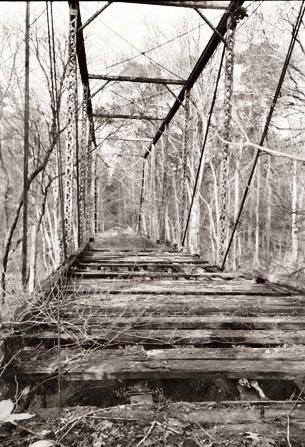 But I do know something about the town's namesake, Brigadier General Elijah Clark, the Hero of the Hornet's Nest, frontiersman and Revolutionary War hero. Born in Edgecombe County, North Carolina, in 1733, Clark moved to what is now Lincolnton, Georgia in 1774. When the Revolutionary War began, Clark joined a militia and earned his nickname for his voraciousness in fighting Tories. "The Hornet's Nest," by the way, refers to the area in Georgia where Clark resided. Clark fought in the battles of Alligator Creek, Kettle Creek, Musgrove's Mill, Fish Dam, Blackstock's, Long Cane, Beatties Mill, and participated in the two sieges at Augusta, helping to successfully defeat the British in the second. Here's another shot of the old bridge at Turkey Creek. Usually, if something is abandoned, I look for a way in, up, down, or across. Here, proving that I'm not a complete idiot, I decided to be content with just a picture from the far end.
But I do know something about the town's namesake, Brigadier General Elijah Clark, the Hero of the Hornet's Nest, frontiersman and Revolutionary War hero. Born in Edgecombe County, North Carolina, in 1733, Clark moved to what is now Lincolnton, Georgia in 1774. When the Revolutionary War began, Clark joined a militia and earned his nickname for his voraciousness in fighting Tories. "The Hornet's Nest," by the way, refers to the area in Georgia where Clark resided. Clark fought in the battles of Alligator Creek, Kettle Creek, Musgrove's Mill, Fish Dam, Blackstock's, Long Cane, Beatties Mill, and participated in the two sieges at Augusta, helping to successfully defeat the British in the second. Here's another shot of the old bridge at Turkey Creek. Usually, if something is abandoned, I look for a way in, up, down, or across. Here, proving that I'm not a complete idiot, I decided to be content with just a picture from the far end.Here's a good tale about Elijah Clark's wife, Hannah. (Thanks to Beverly L. Pack, whoever you are.) During the war, Hannah Clark made some of those shirts that have ruffling down the chest for her handsome husband. You know, the kind fancied by English rock stars in the 1960's, such as Pete Townshend, Brian Jones, and Jimmy Page. Well, Jimi Hendrix liked them too, but he'd lived in London for a bit himself. Anyway, apparently Englishmen have always been known for coveting these frilly shirts, because Hannah was so afraid the British were going to steal them and wear them that she hid all the shirts in the smokehouse when she knew Redcoats were advancing. Somehow raiders heard about the shirts and searched the Clark property, eventually finding the sartorial treasure, while Elijah, a fugitive from the Tories, was out fighting. Not content with just frilly-bosomed shirts, the Redcoats burnt Hannah's house to the ground. No one was injured, but everything was destroyed, save a patchwork quilt made by Hannah's daughters. As if THIS wasn't enough, when Hannah rode away from her smoldering house on her only horse she came across some British troops who tried to take the quilt. Hannah was pissed 'cause the raiders had already stolen the frilly shirts and torched her house and now these guys wanted the quilt her daughters had made for her and so she refused to give it over. The Tories responded by shooting at her, wounding her horse. Hannah didn't budge. Finally, a Redcoat said, "So brave a woman should not be robbed," and the band of marauding would-be quilt thieves rode off. Back in North Augusta, here's a joist ornament from the old ceramic shop just across the bridge on 13th St.
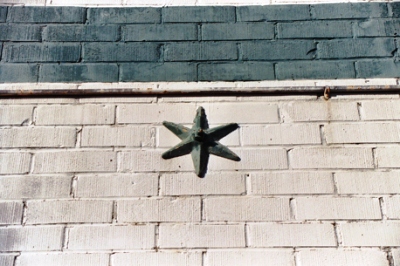
Hannah Clark was a tough cookie. After the house was burned, Elijah moved his family to Tennessee, but when he was severely wounded in the first siege of Augusta in 1780, Hannah rode back with twin babies to nurse him. Later, while riding with these same twins, British troops shot her horse out from under her.
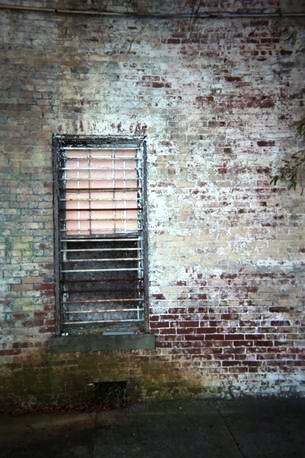 Hannah was at the second siege of Augusta, in 1781, when Fort Cornwallis was surrendered. Eventually dubbed "The Heroine of the Hornet's Nest," Hannah was considered one of the Revolutionary War's greatest women. Elijah died in Richmond Country, Georgia, in 1799. Hannah lived into the late 1820's. The original burial plots in Lincolnton, GA were going to be inundated by the dam reservoir, so the bodies were exhumed and buried in unmarked graves where they were promptly neglected for a number of years. However, the Clark's graves are now a tourist attraction at the aptly named Elijah Clark State Park in Lincolnton. We're back in Augusta proper now, at the corner of Telfair St. and James Brown Blvd. Through the window is an abandoned bar, empty for over a decade. Man, it's been a long time since we've been back in Augusta, hasn't it?
Hannah was at the second siege of Augusta, in 1781, when Fort Cornwallis was surrendered. Eventually dubbed "The Heroine of the Hornet's Nest," Hannah was considered one of the Revolutionary War's greatest women. Elijah died in Richmond Country, Georgia, in 1799. Hannah lived into the late 1820's. The original burial plots in Lincolnton, GA were going to be inundated by the dam reservoir, so the bodies were exhumed and buried in unmarked graves where they were promptly neglected for a number of years. However, the Clark's graves are now a tourist attraction at the aptly named Elijah Clark State Park in Lincolnton. We're back in Augusta proper now, at the corner of Telfair St. and James Brown Blvd. Through the window is an abandoned bar, empty for over a decade. Man, it's been a long time since we've been back in Augusta, hasn't it?A couple items of business: It's come to my attention that there were some formatting problems in Mozilla and Safari. The Mozilla errors have been fixed. I hope that fixed Safari as well. If you experience problems in your browser, please let me know. I'll go in, screw everything up, and fix it in about, oh, six or seven hours. Also, I have some revision work to do on a manuscript. This means I'll be in front of a computer a lot. As I can only stare at a monitor for so long each day, it might be a week or so before I get back to you. In the meantime, browse the now-error-free archives, leave cryptic comments, or just wait a bit to come back. For the next post I'm undecided as to whether to go up the Aiken-Augusta highway to, uh, Aiken, or take a road trip to Cumberland Island. Any opinions? Otherwise, it'll be a surprise. On the other corner of Telfair St. and J.B. Blvd. was the Borden's building, shown below. Makers of fine glues and adhesives. I was down here the morning the mirrored windows were smashed and I don't know why I didn't take a photo then. Duh. Maybe I didn't have a camera with me. I also don't know why I didn't step through the broken windows at the time to see what was inside. I rarely mess with my shots, but I recall rolling a large trash bin full of broken glass out of the way here. This building has since been torn down.
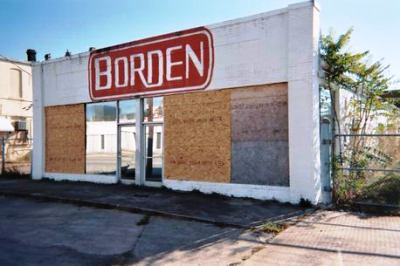
Before I go, I just want to leave you with a quote from Steve Thayer's fine noir novel, Saint Mudd. Here, a character is leaving Sioux Falls, SD and driving to St. Paul, MN: "He rested his wrist on the wheel and bounced east, past decaying barns and farm homes that were home only to the wind. The clouds of dirt he raised made the mirrors useless, but it did not matter; he knew what was back there. Dust. Dust, where corn fields were supposed to be knee-high by the Fourth of July. Dust, where golden rows of wheat were supposed to grow. Everywhere he looked, amber waves of dust." Happy Saint Valentine's Day from the City of Dust! See ya in a week or so.
John,
ReplyDeleteThat's just so capital R Romantic!
-zb
FYI - the "Bordens" sign was actually for a dairy outpost where the milkmen would come in, load up & take their trucks out to make deliveries. My husband used to be one of their milkmen!!
ReplyDeleteThanks. I'm an Augusta native, my mom was from Graniteville, my parents are both buried in the Graniteville cemetery (a site you would have enjoyed). Your site is like taking a trip through my childhood as my parents were history buffs. Also, my dad was an Augusta city policeman and knew all the old shortcuts, buildings and "hangouts", which we all loved to explore.
Keep up the great work!!